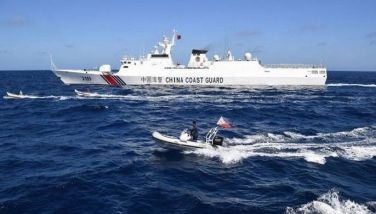US ship sails near China-made isles
WASHINGTON/BEIJING – The US Navy sent a guided-missile destroyer close to China’s man-made islands in the disputed South China Sea yesterday, US defense officials said, a move that could heighten tensions over the strategic waterway.
In Beijing, China’s Vice Foreign Minister Zhang Yesui summoned US Ambassador Max Baucus to protest the US action.
Zhang called the US patrol “extremely irresponsible” and urged Washington to cease actions that harm China’s sovereignty and security interests, China Central Television reported.
Beijing also indicated the move could prompt a stronger Chinese military presence in the area.
The patrol represents the most serious US challenge to 12-nautical-mile territorial limits China asserts around the islands and drew angry rebuke from Beijing, which said last month it would never allow any country to violate its territory in the Spratly archipelago, where seven outposts have been built. Beijing said it followed the movement of the US warship.
“You don’t need to consult with any nation when you are exercising the right of freedom of navigation in international waters,” John Kirby, the State Department spokesman, said at a news conference.
One US defense official said the USS Lassen sailed within 12 nautical miles of Subi Reef. A second official said the patrol, which lasted a few hours, also included Mischief Reef.
The second official said the mission would be the start of a series of challenges to China’s territorial claims in one of the world’s busiest sea lanes.
China’s foreign ministry said the “relevant authorities” monitored, followed and warned the USS Lassen as it “illegally” entered waters near islands and reefs in the Spratlys without the Chinese government’s permission.
“China will resolutely respond to any country’s deliberate provocations,” the ministry said in a statement that gave no details on precisely where the US ship sailed.
Foreign ministry spokesman Lu Kang later told a daily briefing that if the US continued to “create tensions in the region,” China might conclude it had to “increase and strengthen the building up of our relevant abilities.”
Lu did not elaborate, except to say he hoped it did not come to that, but his comments suggested China could further boost its military presence in the South China Sea.
“China hopes to use peaceful means to resolve all the disputes, but if China has to make a response then the timing, method and tempo of the response will be made in accordance with China’s wishes and needs.”
The Chinese embassy in Washington, for its part, said the concept of freedom of navigation should not be used as an excuse for muscle flexing.
The second US official earlier said the ship would likely be accompanied by a US Navy P-8A surveillance plane and possibly a P-3 surveillance plane, which have been conducting regular missions in the region.
Additional patrols would follow in the coming weeks and could also be conducted around features that Vietnam and the Philippines have built up in the Spratlys, the official said.
“This is something that will be a regular occurrence, not a one-off event,” said the official. “It’s not something that’s unique to China.”
White House spokesman Josh Earnest referred questions on any specific operations to the Pentagon but said the United States had made clear to China the importance of free flow of commerce in the South China Sea.
“There are billions of dollars of commerce that float through that region of the world,” Earnest told a news briefing.
The US had not conducted a patrol within 12 miles of the features since China began building the reefs up at the end of 2013. The US Navy last went within 12 miles of Chinese-claimed territory in the Spratlys in 2012.
The decision to go ahead follows months of deliberation and risks upsetting already strained ties with China, the world’s second-biggest economy, with which US business and economic interests are deeply intertwined.
China claims most of the South China Sea, through which more than $5 trillion of world trade passes every year. Vietnam, Malaysia, Brunei, the Philippines and Taiwan have rival claims.
Euan Graham, director of the International Security Program at the Lowy Institute in Sydney, said while there was likely to be a strong vocal reaction from China, its military response could be muted.
“I would expect it would be diplomatically shrill in its reaction. China has also in some ways backed itself into a corner by saying it will exert its sovereignty over the Spratlys,” Graham said.
The patrol could prompt China to do more to exert its sovereignty in the region through further reclamations and greater militarization, he added.
Competing claims
Both Subi and Mischief Reefs were submerged at high tide before China began a massive dredging project to turn them into islands in 2014.
Under the UN Convention on the Law of the Sea, 12-nautical mile limits cannot be set around man-made islands built on previously submerged reefs.
Washington worries that China has built up its outposts with the aim of extending its military reach in the South China Sea. China says they will have mainly civilian uses as well as undefined defense purposes.
Earlier this month an editorial in China’s Global Times newspaper, which is close to the ruling Communist party, condemned Washington’s “ceaseless provocations and coercion” in the South China Sea. - Pia Lee-Brago, Jaime Laude
- Latest
- Trending





























